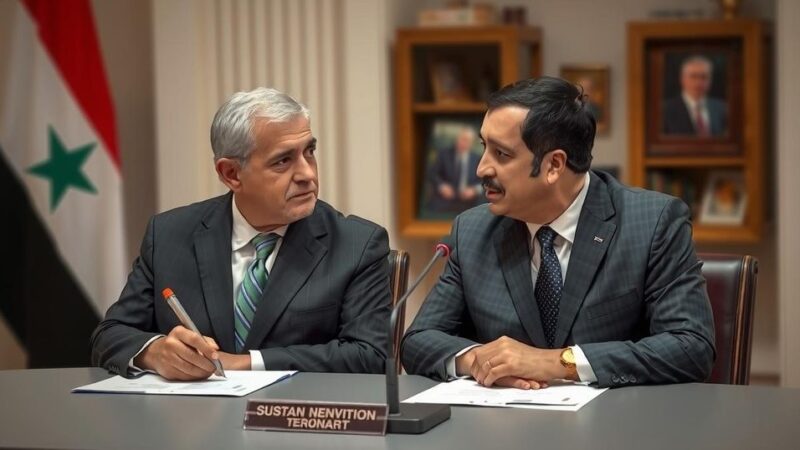This article provides a detailed account of the author’s experience aboard an Israeli tanker during a combat refueling mission aimed at Houthi-controlled positions in Yemen. It highlights the ongoing conflicts involving Israel against multiple adversaries, including Hamas and Hezbollah, and reflects on the broader implications of Israel’s military strategy in the face of regional threats.
Onboard a vintage Boeing 707 jet at high altitude over the Red Sea, I donned advanced 3D goggles while gazing at a diminutive television monitor amidst a cluster of antiquated dials and switches. To my right, Saudi Arabia’s expansive desert unfolded, while Egypt’s coastline appeared to my left, shortly followed by the sight of a formidable F35 fighter jet on the screen. Accompanied by the Israel Defense Forces (IDF) as the first foreign journalist invited to participate in a combat mission beyond Israel’s borders, I was onboard a tanker designated for aerial refueling. Since Hamas’s assault on October 7, Israel has been engaged in an intensifying conflict not solely in Gaza but also against Hezbollah in Lebanon, Houthi rebels in Yemen, and in retaliatory operations across Iran and Syria. The toll of this multifaceted warfare is staggering, with over 42,000 casualties reported in Gaza and 1,000 in Lebanon, while ongoing bombings in Yemen have obliterated vital infrastructure in what is already one of the world’s most dire humanitarian situations. The specifics of our mission were undisclosed as I ascended the deteriorating steps of the aircraft. With stringent security protocols in place, neither Lt. Col. Nadav Shoshani, the accompanying IDF spokesperson, nor I was permitted to bring personal communication devices or cameras. Despite these restrictions, I was granted extensive access to the more than 50-year-old aircraft and its crew—throughout the flight, I understood that these operations were critical in confronting multiple threats faced by Israel. The tanker flew approximately 1,200 miles (1,500 kilometers), marking the IDF’s most protracted refueling operation since the 1985 Tunis raid. Lt. Col. Shoshani referred to Prime Minister Benjamin Netanyahu’s recent declaration to the United Nations, emphasizing Israel’s capability to reach any target. For a duration exceeding one and a half hours, Israeli F35s, each valued at over $100 million, approached the tanker for fuel. The squadron commander, an experienced refueling operator, discussed the complexities of the mission, particularly the necessity of precise timing to ensure the jets received sufficient fuel just before executing an aerial strike. Upon reviewing our flight plan, it became apparent that our destination was Hodeidah Port in Yemen, which is currently under the control of Houthi militants backed by Iran. Recent aggressive maneuvers by the Houthis, including missile attacks targeting Israeli cities, necessitated this preemptive response. The Houthis have consistently linked their actions to solidarity with Palestinians and have aimed threats against Israeli leadership. Following the successful aerial refueling, we circled above the Hodeidah area, waiting for the F35s to deploy their munitions. The lead pilot assured me of their intent to minimize civilian casualties, while recognizing the difficult reality of their mission against an enemy that poses a direct danger to Israeli citizens. Upon returning to Israeli territory post-mission, reports emerged of significant damage in Hodeidah, with the IDF confirming the targeting of strategic locations employed for military supply lines by the Houthis. Statements from senior IDF officials reinforced the message that Israel retains the capacity for precision strikes across the region, with an emphasis on deterring Iranian influence amidst growing tensions with Hezbollah. This event illustrated that Israel’s military operations are evolving into a broader regional conflict with the potential for severe ramifications.
This article sheds light on the current military engagement of Israel, which has seen increased hostilities due to attacks by Hamas, Hezbollah, and Houthi rebels. Since the onset of these hostilities, Israel has intensified its military efforts, resulting in a significant toll on civilian populations in the involved regions. The article describes a first-hand experience aboard an Israeli refuel tanker, highlighting the complexities of military operations in response to foreign threats. Additionally, the narrative captures the implications of geopolitical dynamics, such as Iran’s involvement with the Houthis, and Israel’s strategic military goals amidst regional tensions.
In summary, the IDF’s airborne refueling mission epitomizes Israel’s commitment to countering threats from multiple fronts, particularly by targeting the Houthi-controlled infrastructure in Yemen. As tensions escalate within the region, the importance of precision and timing in military operations becomes ever more critical. The situation underscores the broader ramifications of ongoing conflicts as Israel navigates a complex landscape of adversaries, with national security and regional stability at stake.
Original Source: www.cnn.com







